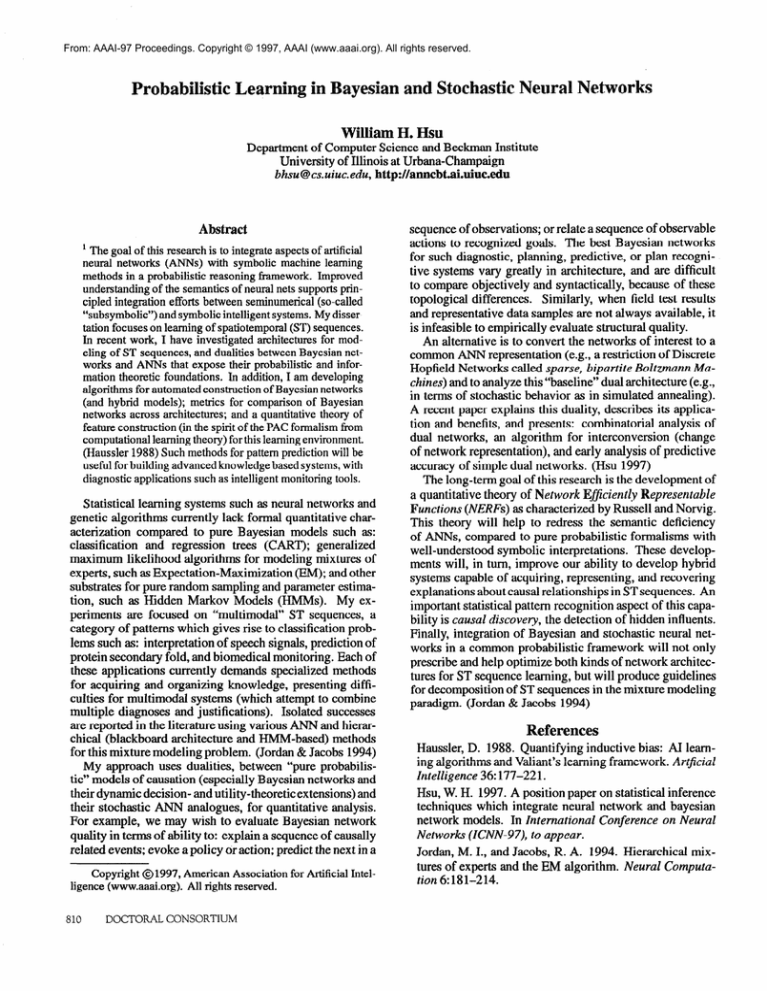
From: AAAI-97 Proceedings. Copyright © 1997, AAAI (www.aaai.org). All rights reserved.
abilistic Learning in Bayesian and Stochastic Neura
William H. Hsu
Department of Computer Science and Beckman Institute
University of Illinois at Urbana-Champaign
bhsu@cs.uiuc.ecZu, http://anncbt.ai.uiuc.edu
Abstract
’ The goal of this research is to integrate aspects of artificial
neural networks (ANNs) with symbolic machine learning
methods in a probabilistic reasoning framework. Improved
understanding of the semantics of neural nets supports principled integration efforts between seminumerical (so-called
“subsymbolic”) and symbolic intelligent systems. My dissertation focuses on learning of spatiotemporal (ST) sequences.
In recent work, I have investigated architectures for modeling of ST sequences, and dualities between Bayesian networks and ANNs that expose their probabilistic and information theoretic foundations. In addition, I am developing
algorithms for automated construction of Bayesian networks
(and hybrid models); metrics for comparison of Bayesian
networks across architectures; and a quantitative theory of
feature construction (in the spirit of the PAC formalism from
computational learning theory) for this learning environment.
(Haussler 1988) Such methods for pattern prediction will be
useful for building advanced knowledge based systems, with
diagnostic applications such as intelligent monitoring tools.
Statistical learning systems such as neural networks and
genetic algorithms currently lack formal quantitative characterization compared to pure Bayesian models such as:
classification
and regression trees (CART); generalized
maximum likelihood algorithms for modeling mixtures of
experts, such as Expectation-Maximization
(EM); and other
substrates for pure random sampling and parameter cstimation, such as Hidden Markov Models (HMMs). My experiments are focused on “multimodal”
ST sequences, a
category of patterns which gives rise to classification problems such as: interpretation of speech signals, prediction of
protein secondary fold, and biomedical monitoring. Each of
these applications currently demands specialized methods
for acquiring and organizing knowledge, presenting difficulties for multimodal systems (which attempt to combine
multiple diagnoses and justifications).
Isolated successes
are reported in the literature using various ANN and hierarchical (blackboard architecture and HMM-based) methods
for- this
- mixture modeling problem. (Jordan & Jacobs 1994)
My approach uses dualities, between “pure probabiiistic” models of causation (especially Bayesian networks and
their dynamic decision- and utility-theoretic extensions) and
their stochastic ANN analogues, for quantitative analysis.
For example, we may wish to evaluate Bayesian network
quality in terms of ability to: explain a sequence of causally
related events; evoke a policy or action; predict the next in a
Copyright @ 1997, American Association for Artificial Intelligence (www.aaai.org).
810
All rights reserved.
DOCTORAL CONSORTIUM
sequence of observations; or relate a sequence of observable
actions to recognized goals. The best Bayesian networks
for such diagnostic, planning, predictive, or plan recognitive systems vary greatly in architecture, and are difficult
to compare objectively and syntactically, because of these
Similarly, when field test results
topological differences.
and representative data samples are not always available, it
is infeasible to empirically evaluate structural quality.
An alternative is to convert the networks of interest to a
common ANN representation (e.g., a restriction of Discrete
Hopfield Networks called sparse, bipartite Boltzmann Machines) and to analyze this “baseline” dual architecture (e.g.,
in terms of stochastic behavior as in simulated annealing).
A recent paper explains this duality, describes its application and benefits, and presents: combinatorial
analysis of
dual networks, an algorithm for interconversion
(change
of network representation), and early analysis of predictive
accuracy of simple dual networks. (Hsu 1997)
The long-term goal of this research is the development of
a quantitative theory of Network Efficl’ently Representable
Functions (NERFs) as characterized by Russell and Norvig.
This theory will help to redress the semantic deficiency
of ANNs, compared to pure probabilistic formalisms with
well-understood symbolic interpretations.
These developments will, in turn, improve our ability to develop hybrid
systems capable of acquiring, representing, and recovering
explanations about causal relationships in ST sequences. An
important statistical pattern recognition aspect of this capability is causal discovery, the detection of hidden influents.
Finally, integration of Bayesian and stochastic neural networks in a common probabilistic framework will not only
prescribe and help optimize both kinds of network architcctures for ST sequence learning, but will produce guidelines
for decomposition of ST sequences in the mixture modeling
paradigm. (Jordan & Jacobs 1994)
Haussler, D. 1988. Quantifying inductive bias: AI learn:,, ~l~r\+;tL¶.%n CLI‘U
nwwl vnl;r.m,‘o
1,wv.m;nn.
flm-+%mX,Ae.b
AY+fi,;“l
,*,g algv~lL,l‘lw
Vcxual‘L
D KcllIllll~
11al11bWV1lL.
n,‘JJILLu.‘
Intelligence 36: 177-22 1.
I-h, W. H. 1997. A position paper on statistical inference
techniques which integrate neural network and bayesian
network models. In International Conference on Neural
Networks (ICNN-97), to appear.
Jordan, M. I., and Jacobs, R. A. 1994. Hierarchical mixtures of experts and the EM algorithm. Neural Computation 6~181-214.




